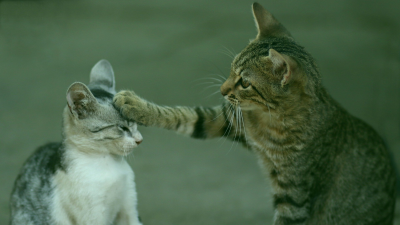Keeping the Peace in a Multi-Cat Household
Ask PHP Pete!
Dear PHP Pete,
We recently welcomed a new feline friend into our home. She is wonderful but our other cats are less than thrilled. Do you have any suggestions for keeping the peace in a multi-cat household?
Thanks,
Feline Frazzled
Dear Feline Frazzled,
Studies show that the social lives of cats can be quite complex. Researchers have examined the behaviors within feral and domestic groups, and have observed that cats are socially flexible: they can live together in groups (especially if there is an ample food supply) or strike out on their own. Females tend to form the core of the group while males may come and go.
Cats that grow up together are more likely to bond. Socialization occurs at a young age when kittens are around 2-7 weeks old. It may take time for newcomers to join the group.
Although cats can live in large groups (or a smaller group within a home), several factors should be considered when adding a new member to the group:
A Place to Call Her Own
Cats tend to have specific spots they prefer, and mostly stick to those locations. It is ideal to provide additional cat-designated spaces into your home, such as cat trees, shelves, and walkways. This may help reduce fights over territory and offer retreats.
Cautious Introductions to a Multi-Cat Household
Since a new kitty will not have the benefit of growing up with her new friends, it may take time for them to establish a relationship. They may need to be separated temporarily and introduced gradually, such as through a screen door. Another way to create a positive association is feeding them near each other; however, as the next section explains, mealtimes may present other complications to take into account.
Feeding on Her Terms
Different cats approach mealtimes in different ways. A dominant cat may intimidate a weaker cat. Some cats eat fast while others nibble a little at a time.
The goal when feeding multiple cats is to give each cat an equal chance for nutrition. One option is to provide multiple feeding sites to help minimize squabbles. It may be necessary to isolate certain cats at mealtime, especially if they eat slowly or require a special diet.
A Clean Latrine
Cats are clean creatures and may not use a dirty litter pan. For this reason, ideally, you should have one more litter pan than you do cats (for example, if you have 3 cats you should have 4 litter pans). If possible, place them in different locations to minimize territory encroachment. Litter pans should be cleaned at least once a day and washed once a week.
Medication Options
Some over-the-counter and prescription medications may help alleviate anxiety and ease tensions between cats. Calming pheromones are sold at pet stores and online. If necessary, there are also anti-anxiety medications such as fluoxetine and amitriptyline that may be prescribed by your veterinarian. It is important to remember some medications may take time to show the full effect.
Conclusion
Integrating a new cat into your family takes patience and careful consideration of the individual needs of each cat. Your veterinarian may have additional ideas to help the introduction go more smoothly. Best wishes and congratulations on your new furry family member!
Sincerely,
PHP Pete
- Bernstein PL. Behavior of Single Cats and Groups in the Home. Consultations in Feline Internal Medicine. 2006;675-685. doi:10.1016/B0-72-160423-4/50074-3 https://www.ncbi.nlm.nih.gov/pmc/articles/PMC7149619/.
- Neilson J. Top 10 cat behavior tips. (2005) https://www.dvm360.com/view/top-10-cat-behavior-tips. Accessed June 2020.






